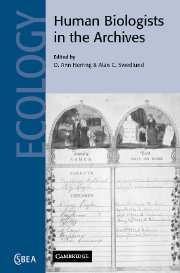 Human Biologists in the Archives
Human Biologists in the Archives Published online by Cambridge University Press: 12 August 2009
Introduction
The Hudson's Bay region of the Canadian north captured the imagination of seventeenth-century Europeans seeking the elusive northwest passage to the Far East. The romance of the north and its promise of future riches led adventurers and agents of foreign governments to explore its land and sea. They encountered a fabulous array of fur-bearing animals – beaver, ermine, mink, fox, fisher, marten, lynx, hare and muskrat – setting the stage for the development of the European fur trade and for significant shifts in human–land relationships in the north thereafter.
A system of fur trade posts was established by the Hudson's Bay Company and the Northwest Company (which merged into a single business in 1821) that served to attract Aboriginal people to the areas around the posts and to encourage more intensive trapping of fur-bearing animals, in exchange for European goods (Fig. 13.1). Prior to sustained European contact, the Cree followed a seasonal subsistence cycle based on shifting plant and animal availability (Fig. 13.2). During the fur trade, they became enmeshed in a European industry that intensified and concentrated their subsistence activities on harvesting fur-bearing animals such as the beaver. This eventually led to abandonment of the seasonal cycle of mobility and to an increasing dependence on particular tracts of land, the economy of the fur trade, and imported resources.
The demographic and ecological consequences of the fur trade, though seemingly minor at the outset, acted incrementally through time to transform life in the Canadian north (Preston 1986).
To save this book to your Kindle, first ensure [email protected] is added to your Approved Personal Document E-mail List under your Personal Document Settings on the Manage Your Content and Devices page of your Amazon account. Then enter the ‘name’ part of your Kindle email address below. Find out more about saving to your Kindle.
Note you can select to save to either the @free.kindle.com or @kindle.com variations. ‘@free.kindle.com’ emails are free but can only be saved to your device when it is connected to wi-fi. ‘@kindle.com’ emails can be delivered even when you are not connected to wi-fi, but note that service fees apply.
Find out more about the Kindle Personal Document Service.
To save content items to your account, please confirm that you agree to abide by our usage policies. If this is the first time you use this feature, you will be asked to authorise Cambridge Core to connect with your account. Find out more about saving content to Dropbox.
To save content items to your account, please confirm that you agree to abide by our usage policies. If this is the first time you use this feature, you will be asked to authorise Cambridge Core to connect with your account. Find out more about saving content to Google Drive.